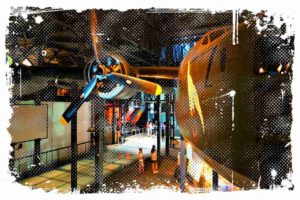Krzemionki Opatowskie, located near Ostrowiec Świętokrzyski, have a distinct history. It consists of a series of prehistoric striped flint mines and associated settlements. In addition to Krzemionki, there are the mines of Borownia and Korycina, as well as a Neolithic settlement on the hill of Gawroniec.

The flint mines were discovered in 1922 by Prof. Jan Samsonowicz, a geologist from Ostrowiec. It was soon proclaimed an official monument and has been protected as a historical monument since 1994 and as a nature reserve since 1995.
Who is for? The Museum and Reserve in Krzemionki is a perfect destination for families, groups of young adults or adults. It’s a great opportunity to experience Poland’s 16th entry on the UNESCO World Heritage List. In addition to Krzemionki, other sites on the list include the Lead, Silver and Zinc Mine in Tarnowskie Góry, the charming Old Town of Krakow, the magnificent Teutonic Castle in Malbork, and the charming medieval town of Toruń. You can check all of them here: Exploring Poland’s Cultural Riches: A Guide to UNESCO Cities.
The architecture of Krzemionki is surprisingly well preserved. This includes the pits and galleries used by the miners, as well as the surface landscape. You can also see shaft funnels, former mine entrances, and limestone rubble. There are also several types of mines, from the shallowest cave to niche mines and deep pillar mines.
↳ PRO TIP: Do you like traveling? Then before you buy any ticket or book an attraction, check if it's available in this worldwide Viator Database. You may save a lot of money and time. No need to thank me :)
The museum in Krzemionki is visited by approximately 33,000 tourists annually.
The Flint Formation in That Region
Even after extensive study, scientists are still uncertain about the source of silica, the main component of flint, and the rate and temperature at which it crystallized. Because of the different theories about the source and conditions of silica formation, finding a universal formula for making flint is a major puzzle for scientists.
We know that the striped flint of the Świętokrzyskie Province was formed about 155 million years ago in the Late Jurassic period, when the area was submerged by a warm shallow sea. The shallow sea contained limestone deposits and silica, which was able to settle, often in burrows dug by small crustaceans similar to modern shrimp.

Over time, the slimy deposits dried out and became solid stone, also known as flint. Now, as you stroll along the tourist path below the surface, you will see the prominent flint rocks that follow the winding tunnels of the Jurassic crabs.
Post-Industrial Landscape From Thousands of Years Ago
When you visit the museum, you will get to see some of the sprawling 78-acre mining field. Scientists believe that this area is home to nearly 4,000 mines. This reserve also preserves a Stone Age mining site. It features dumps, entrances to underground mines, and the remains of workshops where flint was shaped.
Underground, the pits range in depth from 3 to 9 m. In the past, miners worked in different types of mines, each with its own depths and mining methods. These included:
- cave mines – simple, uncomplicated, shallow mines that were up to 2 meters deep;
- niche mines: they were a little deeper (from 2.5 to 4 meters); in their lower part, miners dug characteristic niches several meters deep, which extended the deposit’s mining area;
- gallery mines: small galleries excavated at the bottom of the shaft at a depth of up to 7 meters in soft ground (e.g., clay).
- pillar mines: in this type of mine, miners left intact sections of rock that acted as pillars to keep the roof from collapsing; the tunnels reached up to 8 meters from the shaft and were drilled to a depth of 5-6 meters.
A Difficult Job For Former Miners
Clearly, miners needed specialized knowledge in order to locate a suitable mine site, ensure its safety, and extract flint. It is likely that specialized group of miners was delegated to perform this specific task.
The task was not easy. The miners had to work on their knees or even face down in pits between 55 and 110 centimeters deep. They lit these areas with tar-wood arches. Unfortunately, they often had to work in temperatures of 5 to 9 degrees Celsius with high humidity, which led to health problems such as pneumoconiosis and rheumatism. In addition, accidents were a common risk when working in the mines.
Those employed in mining used rudimentary stone, flint, wood, and antler tools. They were skilled and talented enough to extract flint from below the surface and then bring it up in baskets or sacks.
Next to the shafts were places for the processing of the flint. They broke large chunks into smaller sizes, from which they made axes and chisels. At the peak of its popularity, they were delivered up to 660 kilometers from Krzemionki!
Krzemionki – Trails and Routes
The Krzemionki Tourist Trail takes you on an incredible journey back in time to a time when prehistoric industry flourished 5,000 years ago. The only one of its kind open to the public, you will see the original pits of Neolithic mines, mining heaps, and post-mining hollows along the 500-meter underground route. You will have a great opportunity to understand how the miners used to work.

In the multi-media exhibition „Lords of Flint” (pl: Władca Krzemienia) you will be able to explore the connection between everyday life and the mining industry. There is a model of the settlement, people, and animals. You can also see a reconstructed grave belonging to the Mierzanowic culture. I think you also shouldn’t miss multimedia presentations and authentic Neolithic and Early Bronze Age objects related to mining.
Krzemionki Opatowskie – Practical Information
You can stop at the museum to rest and enjoy a cup of tea or coffee in the café. If you are looking for something special, there are souvenir and mineral shops nearby. They have many great items.
The tour of the reserve is 2 kilometers long and includes a bit of underground, so be sure to bring something warm to wear.
It can be chilly below the surface even when the weather is nice. If you take your time and explore all of Krzemionki, it will probably take you a couple of hours, but if you are in a hurry, you can do it in 1.5 or 2 hours. Of course, this also depends on whether you decide to stop for a snack or to buy souvenirs.
It is fascinating to note that up to 384 different plant species have been documented in the reserve, 39 of which are rare and protected.
Tour Prices and Opening Hours
A visit to the Museum and Reserve costs 8 zlotys for a regular ticket or 5 zlotys for a discounted ticket. You should plan your visit accordingly, as the tours are available at different times during the week.
- Tours are available at 9:30, 10:30, 11:30, 12:30, 14:30, and 15:30 from Monday through Friday.
- On weekends at 9:30, 11:30, 13:30, and 15:30.
Bibliography
- https://pl.wikipedia.org/wiki/Krzemionki
- https://muzeumostrowiec.pl/krzemionki/
- https://skomplikowane.pl/na-trasie/krzemionki-opatowskie/



